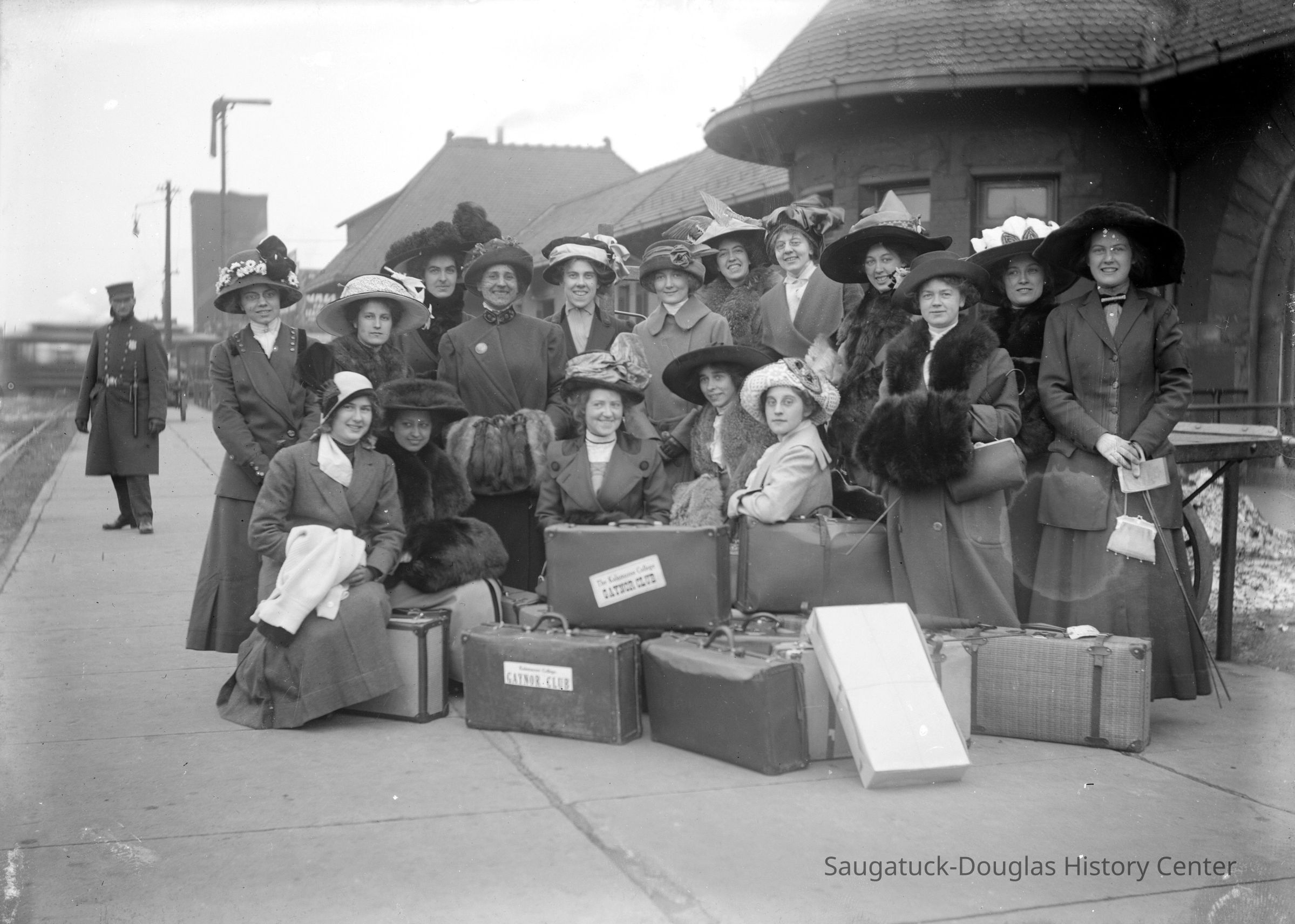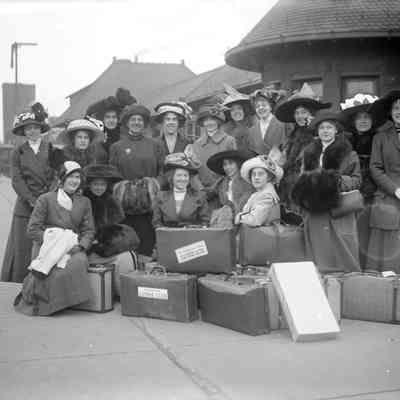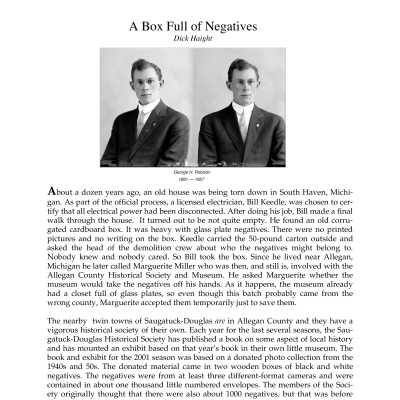Name/Title
George H. Robinson glass negativesEntry/Object ID
2023.57.14Description
CD containing a PDF and a Powerpoint presentation by Dick Haight about a box of glass negatives, how they came to the SDHS and what they turned out to be.Photograph Details
Type of Photograph
DigitalContext
Introductory text from Mr. Haight's PDF. About a dozen years ago, an old house was being torn down in South Haven, Michigan. As part of the official process, a licensed electrician, Bill Keedle, was chosen to certify that all electrical power had been disconnected. After doing his job, Bill made a final walk through the house. It turned out to be not quite empty. He found an old corrugated cardboard box. It was heavy with glass plate negatives. There were no printed pictures and no writing on the box. Keedle carried the 50-pound carton outside and
asked the head of the demolition crew about who the negatives might belong to. Nobody knew and nobody cared. So Bill took the box. Since he lived near Allegan, Michigan he later called Marguerite Miller who was then, and still is, involved with the Allegan County Historical Society and Museum. He asked Marguerite whether the museum would take the negatives off his hands. As it happens, the museum already had a closet full of glass plates, so even though this batch probably came from the wrong county, Marguerite accepted them temporarily just to save them.
The nearby twin towns of Saugatuck-Douglas are in Allegan County and they have a vigorous historical society of their own. Each year for the last several seasons, the Saugatuck- Douglas Historical Society has published a book on some aspect of local history and has mounted an exhibit based on that year’s book in their own little museum. The book and exhibit for the 2001 season was based on a donated photo collection from the 1940s and 50s. [Simmons Collection] The donated material came in two wooden boxes of black and white negatives. The negatives were from at least three different-format cameras and were contained in about one thousand little numbered envelopes. The members of the Society originally thought that there were also about 1000 negatives, but that was before they discovered that some envelopes contained as many as a dozen images and that the total was nearer 3000. A volunteer took samples to a nearby commercial photo finisher for an estimate. It turned out that since the work could not be automated, the cost would be about $3.50 per negative, or over $10,000.
That was when someone remembered that I had the sort of computer background that might be useful in this situation. As a result my advice, the society now has a Macintosh graphics computer connected to a high-quality photo scanner that can convert both photo prints and negatives into digital images. The computer system cost under $5000 and it has been used to do lots of other tasks beyond just viewing the 3000 negatives. One of the things that it turned out to be good at was scanning old glass plate transparencies. I didn’t plan it that way — it just happened to work out.
In the fall of 2001 the society started work on their 2002 book about shipwrecks of the Saugatuck area. [Storm, Fire and Ice] Kit Lane, society president and co-author of the new book, wanted pictures of artifacts from a locally-famous wreck, the Chicora. The artifacts are housed in the old county jail building in Allegan, which is now the Allegan County Museum. So she dragged her co-author, Jack Sheridan, and me to Allegan. Here the plot thickens: As you have guessed by now, the people equipped to scan glass plates have arrived at the temporary home of the orphaned negatives. And guess who greeted us at the museum?
Well, that self-same Marguerite Miller who had saved the negatives a decade earlier, that’s who. And after we photographed the Chicora’s mast and purser’s cashbox, Marguerite rather forcefully offered us a 50-pound box of glass plate negatives to take back with us. It felt like being offered a second helping of dessert after Thanksgiving dinner, but how could we refuse? Jack is younger than I am so he got to carry the box to the car. There seemed to be no urgency about that box. It hadn’t even been found in our county.
But a week or so later, Jack held a few negatives up to the light and, as a result, took some promising plates to the Saugatuck-Douglas Library — where the Historical Society’s Macintosh computer is housed. And there he scanned them.
Surprise, surprise! Most of the pictures were not taken in South Haven
proper. As a guess, 30% were taken at Kalamazoo College and another 50% at or near a farm called Fern Glen that was at the northern (i.e., Allegan County) edge of South Haven. The remainder are mostly of unidentified and now unidentifiable places.Collection
Family HistoryCataloged By
Winthers, SallyAcquisition
Accession
2023.57Acquisition Method
Found in CollectionLocation
119 C CDs Presentations/Programs
Relationships
Related Person or Organization
Person or Organization
Sheridan, John "Jack" O. 1938-, Haight, Dick, Lane, Kit 1939-2024Create Date
December 9, 2023Update Date
December 15, 2023

